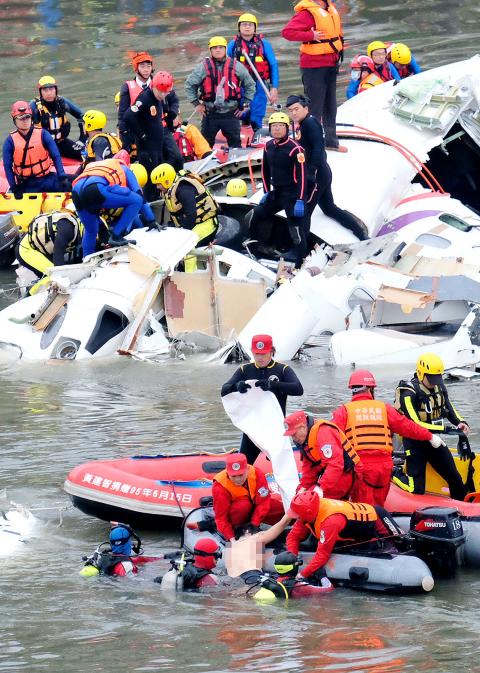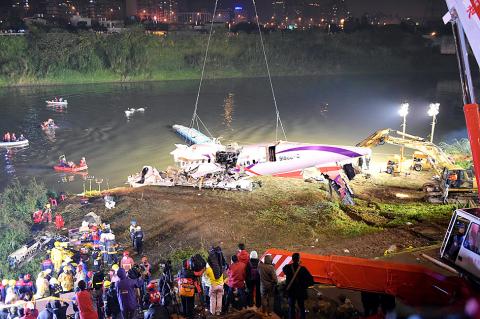A TransAsia Airways (復興航空) airplane flying from Taipei to Kinmen crashed into the Keelung River yesterday, killing at least 25 people, the Civil Aeronautics Administration (CAA) said.
Flight GE235 took off from Taipei International Airport (Songshan airport) at 10:52am, said the agency, which confirmed that it received a “Mayday” signal from the plane’s pilots at 10:53:35am.
Air traffic control personnel tried raising the pilots, but to no avail. Weather data provided by the control tower showed that visibility was 10km when the plane, an ATR 72-600, departed from Songshan airport.

Photo: Sam Yeh, AFP
The weather was quite stable, the CAA said.
The Aviation Safety Council, which is in charge of investigating the cause of the accident, said that it had found the flight data recorder and cockpit voice recorder — also known as the “black boxes” — and would soon start decoding the data.
The data are critical in identifying the cause of the air crash.

Photo: AFP
The plane was carrying 58 people on board: 53 passengers and five cabin crew members.
Thirty-one of the passengers are Chinese tourists, and 27 are Taiwanese. The plane was jointly piloted by 42-year-old Liao Chien-tsung (廖建宗) and 45-year-old Liu Tse-chung (劉自忠), with 4,914 hours and 6,922 hours of flying experience respectively.
Hong Bing-chung (洪炳衷), the copilot, served as an observer during flight as he was training to operate ATR 72-600 aircraft.

Photo: Liao Chen-huei, Taipei Times
Both Liao and Liu are experienced in flying ATR 72-type aircraft, with their flying hours topping 3,400 and 6,500 respectively.
The accident yesterday is TransAsia’s second crash within a year’s time. One of the airline’s ATR 72-500 aircraft crashed on July 23 last year at a village near Magong Airport in Penghu County, killing 48 people and injuring 10 people on board.
TransAsia management bowed and apologized to the victims and their families.
CEO Peter Chen (陳欣德) said that seven of the Taiwanese passengers purchased their tickets at Songshan airport’s check-in counters and only left their ID numbers, adding that the company was still trying to reach the families of the seven passengers.
Ten of the Taiwanese passengers are from Kinmen, he said.
Chen said the Chinese passengers were traveling with the Kaohsiung-based travel agencies Flying Tours (飛揚旅行社) and Sweet Tour (德運旅行社), in cooperation with agencies in Xiamen, China.
TransAsia has asked the travel agencies to help contact the families of the victims, Chen said.
Chen said the company would not speculate on the cause of the air crash, and would fully cooperate with the authorities in the investigation.
The company confirmed that the airplane’s No. 1 engine was replaced with a new one provided by the manufacturer, Pratt & Whitney Canada, when the plane first landed in Macau on its way to Taiwan. The No. 1 engine had only been in operation for 800 hours, the company said.
Chen said the ATR 72-600 aircraft were purchased to replace the company’s ATR 72-500 airplanes as part of its move to upgrade its fleet.
Yu Yi-shi (喻宜式), deputy director of the CAA’s flight standards division, said that Uni Air (立榮航空) has 12 ATR 72-600 planes, while TransAsia has six ATR 72-500s and four ATR 72-600s.
He said that all of the nation’s ATR 72-type airplanes will undergo special inspection in the next two days.
“Because the accident happened with TransAsia’s airplanes, the airline is given one night to complete all the examinations before their aircraft could be cleared to take off on Feb. 5, including engines, propellers. Uni, on the other hand, must finish the same process before Feb. 6,” Yu said.
Information from both the CAA and TransAsia showed that the airline received the aircraft on April 14 last year, with the last maintenance being done on Jan. 26.
Meanwhile, the Environmental Protection Administration (EPA) responded shortly after the crash to address possible fuel leakage.
EPA Department of Environmental Monitoring and Information Management Director-General Chu Yu-chi (朱雨其) said his agency had deployed four survey sites along the section of the river between Nanhu Bridge (南湖大橋) and Minquan Bridge (民權大橋), where the accident took place, to monitor water quality within a 5km stretch along the Keelung River every two hours.
The EPA has also requested help from the Taipei City and New Taipei City governments to deploy two fuel locks under the Rainbow (彩虹橋) and Chengmei (成美橋) bridges to contain possible leakage and driftage, Department of Water Quality senior specialist Wei Wen-yi (魏文儀) said.
Additional reporting by Sean Lin

SECURITY: As China is ‘reshaping’ Hong Kong’s population, Taiwan must raise the eligibility threshold for applications from Hong Kongers, Chiu Chui-cheng said When Hong Kong and Macau citizens apply for residency in Taiwan, it would be under a new category that includes a “national security observation period,” Mainland Affairs Council (MAC) Minister Chiu Chui-cheng (邱垂正) said yesterday. President William Lai (賴清德) on March 13 announced 17 strategies to counter China’s aggression toward Taiwan, including incorporating national security considerations into the review process for residency applications from Hong Kong and Macau citizens. The situation in Hong Kong is constantly changing, Chiu said to media yesterday on the sidelines of the Taipei Technology Run hosted by the Taipei Neihu Technology Park Development Association. With

CARROT AND STICK: While unrelenting in its military threats, China attracted nearly 40,000 Taiwanese to over 400 business events last year Nearly 40,000 Taiwanese last year joined industry events in China, such as conferences and trade fairs, supported by the Chinese government, a study showed yesterday, as Beijing ramps up a charm offensive toward Taipei alongside military pressure. China has long taken a carrot-and-stick approach to Taiwan, threatening it with the prospect of military action while reaching out to those it believes are amenable to Beijing’s point of view. Taiwanese security officials are wary of what they see as Beijing’s influence campaigns to sway public opinion after Taipei and Beijing gradually resumed travel links halted by the COVID-19 pandemic, but the scale of

A US Marine Corps regiment equipped with Naval Strike Missiles (NSM) is set to participate in the upcoming Balikatan 25 exercise in the Luzon Strait, marking the system’s first-ever deployment in the Philippines. US and Philippine officials have separately confirmed that the Navy Marine Expeditionary Ship Interdiction System (NMESIS) — the mobile launch platform for the Naval Strike Missile — would take part in the joint exercise. The missiles are being deployed to “a strategic first island chain chokepoint” in the waters between Taiwan proper and the Philippines, US-based Naval News reported. “The Luzon Strait and Bashi Channel represent a critical access

Pope Francis is be laid to rest on Saturday after lying in state for three days in St Peter’s Basilica, where the faithful are expected to flock to pay their respects to history’s first Latin American pontiff. The cardinals met yesterday in the Vatican’s synod hall to chart the next steps before a conclave begins to choose Francis’ successor, as condolences poured in from around the world. According to current norms, the conclave must begin between May 5 and 10. The cardinals set the funeral for Saturday at 10am in St Peter’s Square, to be celebrated by the dean of the College